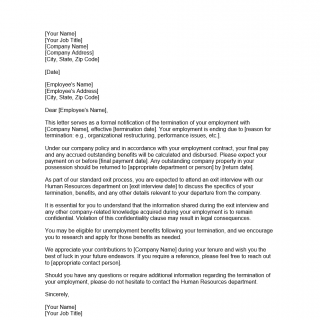End of Employment Letter
An end of employment letter, sometimes referred to as a termination letter, formally notifies an employee that their employment with the company is ending. It is typically issued by the employer and covers various situations, such as layoffs, resignations, or the conclusion of a project.
Form Parts:
- Heading: Includes the company name, address, and date.
- Recipient's details: The employee's name and address.
- Subject: A brief statement indicating the purpose of the letter, such as "Notice of End of Employment."
- Body: Explains the reason for the termination, final pay and benefits, and any other relevant information.
- Signature: The letter should be signed by an authorized representative of the company, such as a manager or HR representative.
- Additional documentation: As needed, to outline any severance package or other necessary forms.
Important Fields:
- Reason for termination: Clearly state the basis for the end of employment.
- Final pay and benefits: Detail any outstanding wages, bonuses or benefits, as well as when they will be paid.
- Last working day: Inform the employee of the last day of their working relationship with the company.
In what cases is this form compiled, and who are the parties to the document:
The end of employment letter can be compiled in various scenarios, including employee resignation, layoff due to company restructuring, end of contract or project, or termination for cause. The parties involved in this document are the employer, who sends the letter, and the employee, who is being terminated or whose employment is ending.
Features to consider when compiling:
- Legal compliance: Ensure the letter adheres to all applicable labor laws and contractual obligations.
- Clarity: Be concise and clear in communicating the reason for termination and any expectations from the employee.
- Professionalism: Maintain a respectful and professional tone.
- Documentation: Retain a copy of the letter for company records.
Sample:
[Your Name]
[Your Job Title]
[Company Name]
[Company Address]
[City, State, Zip Code][Date]
[Employee's Name]
[Employee's Address]
[City, State, Zip Code]Dear [Employee's Name],
This letter serves as a formal notification of the termination of your employment with [Company Name], effective [termination date]. Your employment is ending due to [reason for termination: e.g., organizational restructuring, performance issues, etc.].
Under our company policy and in accordance with your employment contract, your final pay and any accrued outstanding benefits will be calculated and disbursed. Please expect your payment on or before [final payment date]. Any outstanding company property in your possession should be returned to [appropriate department or person] by [return date].
As part of our standard exit process, you are expected to attend an exit interview with our Human Resources department on [exit interview date] to discuss the specifics of your termination, benefits, and any other details relevant to your departure from the company.
It is essential for you to understand that the information shared during the exit interview and any other company-related knowledge acquired during your employment is to remain confidential. Violation of this confidentiality clause may result in legal consequences.
You may be eligible for unemployment benefits following your termination, and we encourage you to research and apply for those benefits as needed.
We appreciate your contributions to [Company Name] during your tenure and wish you the best of luck in your future endeavors. If you require a reference, please feel free to reach out to [appropriate contact person].
Should you have any questions or require additional information regarding the termination of your employment, please do not hesitate to contact the Human Resources department.
Sincerely,
[Your Name]
[Your Job Title]
Advantages:
- Legal protection: The letter can serve as a legal record in case of disputes following the termination.
- Clarity: It provides both the employer and employee a clear understanding of the situation.
- Ease of processing: The letter streamlines administrative processes such as final pay distribution or release of any benefits.
Problems:
- Emotional distress: The letter may create tension or distress for the employee receiving it, affecting their well-being or future job search.
- Legal disputes: If not well-crafted, the letter may lead to legal disputes on the grounds of wrongful termination or allegations of violation of labor laws.
Related forms:
- Resignation letter: Written by the employee to notify the employer of their decision to end their employment
- Job abandonment letter: Written by the employer when an employee has not shown up to work for a specific period without any explanation.
Where and how the form is submitted, and where it is stored:
The letter should be hand-delivered, mailed, or sent via email to the employee. Employers should maintain a copy in the employee's personnel file for their records.

